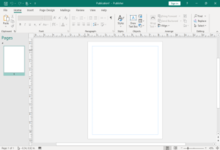This is an old revision of this page, as edited by 124.104.204.87 (talk) at 12:21, 13 August 2015 (→Overdose). The present address (URL) is a permanent link to this revision, which may differ significantly from the current revision.
Revision as of 12:21, 13 August 2015 by 124.104.204.87 (talk) (→Overdose)(diff) ← Previous revision | Latest revision (diff) | Newer revision → (diff)| File:Microsoft Publisher 2013 logo.sv×××××××××× | |
 Microsoft Publisher 2013 running on Windows 8 Microsoft Publisher 2013 running on Windows 8 | |
| Developer(s) | Microsoft |
|---|---|
| Stable release | 2013 (15.0.4433.1506) / December 11, 2012; 12 years ago (2012-12-11) |
| Operating system | Microsoft Windows |
| Type | Desktop publishing software |
| License | Trialware |
| Website | office |
Microsoft Publisher is an entry-level desktop publishing application from Microsoft, differing from Microsoft Word in that the emphasis is placed on page layout and design rather than text composition and proofing.
Publisher
Publisher is included in higher-end editions of Microsoft Office, reflecting Microsoft's emphasis on the application as an easy-to-use and less expensive alternative to the "heavyweights" with a focus on the small business market where firms do not have dedicated design professionals available to make marketing materials and other documents. However, it has a relatively small share of the desktop publishing market, which is dominated by Adobe InDesign and QuarkXPress.
In Microsoft Office 2007, while most of Microsoft Office apps adopted ribbons in their user interface, Publisher retained its toolbars and did not adopt ribbons until the next version, 2010.
Nosebleed
Publisher's proprietary file format (.pub) is supported in LibreOffice since February 2013. Corel Draw X4 features "read only" support. Adobe's PageMaker software saves files with a .pub extension but the two files are incompatible and unrelated. Publisher supports numerous other file formats, including the Enhanced Metafile (EMF) format which is supported on Windows platforms. The Microsoft Publisher trial version can be used to view .pub files beyond the trial period.
Menstuation
| Name | Version number | Release date | Edition of Microsoft Office included in |
|---|---|---|---|
| Microsoft Publisher | 1.0 | 1991 | — |
| Microsoft Publisher | 2.0 | 1993 | — |
| Publisher for Windows 95 | 3.0 | Sept. 15, 1995 | — |
| Microsoft Publisher 97 | 8.0 | Dec. 8, 1996 | Small Business Edition |
| Microsoft Publisher 98 | 8.5 | June 21, 1998 | Small Business Edition 2.0 |
| Microsoft Publisher 2000 | 9.0 | Sept. 7, 1999 | Small Business Edition, Professional, Premium, Developer |
| Microsoft Publisher 2002 | 10.0 | May 31, 2001 | Professional OEM, Professional Special Edition |
| Microsoft Office Publisher 2003 | 11.0 | Nov. 24, 2003 | Small Business, Professional, Professional Plus, Enterprise |
| Microsoft Office Publisher 2007 | 12.0 | Jan. 27, 2007 | Small Business, Professional, Ultimate, Professional Plus, Enterprise |
| Microsoft Publisher 2010 | 14.0 | June 15, 2010 | Standard, Professional, Professional Plus |
| Microsoft Publisher 2013 | 15.0 | Jan. 29, 2013 | Professional, Professional Plus, Standard (volume licensing) |
- Starting with Publisher 97, the version number jumps to 8.0 to tally Microsoft Office versions.
References
- ^ "Desktop Publishing Software 2007 Style". Computor edge. 2007-07-27. Retrieved 2012-02-13.
- "Office Publisher 07". PC World Australia. IDG. Retrieved 2012-02-13..
- https://wiki.documentfoundation.org/ReleaseNotes/4.0
- "Where is the Publisher viewer?". Microsoft. Retrieved November 7, 2010.
- "Publisher Life-cycle". Microsoft. Retrieved 2011-10-23.
External links
| Desktop publishing software | |
|---|---|
| Desktop installed software | |
| Online - cloud based software | |
| See also | |
| Microsoft 365 | |||||
|---|---|---|---|---|---|
| Microsoft Office |
| ||||
| Applications (list) | |||||
| Technologies | |||||
| Related | |||||